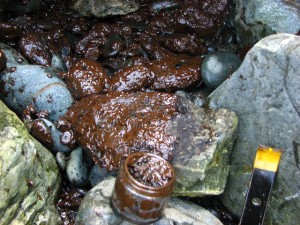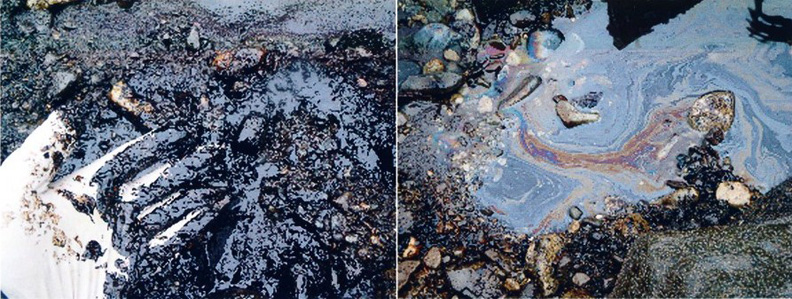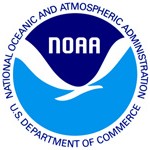Why were we sampling?

Photo of Exxon Valdez oil tanker grounded on Bligh Reef and leaking oil, March 1989. Photo courtesy of NOAA/NMFS.
In March 1989, the Exxon Valdez tanker ran aground on Bligh Reef in eastern Prince William Sound (PWS), spilling an estimated 11 million gallons of crude oil. In the days following, spilled oil moved south and west through PWS and then into the Gulf of Alaska. Roughly 40% of the spilled oil landed on beaches within PWS, affecting at least 487 miles of shoreline. The extent and degree of oiling on shorelines decreased rapidly over the first few years after the spill, and it was assumed that remaining oil would be reduced to negligible amounts soon thereafter. However, observations eight years after the spill showed that oil remained in some beaches leading to concerns that lingering oil could continue to harm wildlife populations and their prey. Lingering oil surveys during the 2000s continued to verify that oil was persisting longer than experts expected and remained relatively un-weathered chemically. The oil weathering project of Gulf Watch Alaska was designed to continue monitoring the persistence and chemical state of lingering Exxon Valdez oil on impacted beaches .
Where were we sampling?
Lingering oil surveys: We re-surveyed approximately ten of the worst case sites with lingering oil in PWS selected from historic sampling results. These sites became the long- term monitoring sites for lingering oil and are intended to be sampled every 5 years over the next 20 years.
Chemical state of the oil: Analyses were from archived Exxon Valdez oil samples housed at Auke Bay Laboratories in Juneau, Alaska and samples from future lingering oil monitoring sites in PWS.

Lingering oil from shallow pit dug in Prince William Sound, 2008. Animals that feed on benthic shellfish and other invertebrates, such as sea otters and Harlequin ducks, showed persistent weakened immunity and reduced reproductivity associated with high levels of poly aromatic hydrocarbons (PAH) from lingering oil. Photo by Dave Janka from EVOSTC website.
How were we sampling?
Lingering oil surveys: Surveys were conducted as they have been in the past by sampling random pit locations. Pits were dug 20 inches deep and evaluated for lingering oil. If oil was found, samples were taken for chemical analyses.
Chemical state of the oil: Over the decades, oil degrades in the environment, so it is critical we are able to identify Exxon Valdez oil (through its “chemical fingerprint”) and understand how it is changing or weathering over time. Using oil samples taken over the last several decades, studies have been focusing on determining levels of geochemical biomarkers. These biomarkers are compounds found in oil that are the most resistant to weathering, therefore yielding a better picture of weathering.
What did we find?
Lingering oil surveys: The amount of lingering oil is small relative to the amount that originally stranded and presumably has diminished since the last quantitative estimate was conducted (in the early 2000s). A lingering oil monitoring survey was conducted in PWS during the summer of 2015 at ten sites known to have persistent subsurface Exxon Valdez oil. Continued monitoring at these sites will allow us to quantify how much oil remains at these locations and the rate at which the oil is diminishing and also assess the oil’s chemical state through time.
Chemical state of the oil: The chemical composition (fingerprint) of oil samples from 2012 continues to be consistent with Exxon Valdez oil. In addition, new forensic modeling approaches with geochemical biomarkers are providing a definitive identification of oil decades after the spill. Oil remains biologically available at some PWS and Gulf of Alaska locations, it so could affect the marine ecosystem.






